AMD's Richland vs. Intel's Haswell GPU on the Desktop: Radeon HD 8670D vs. Intel HD 4600
by Anand Lal Shimpi on June 6, 2013 12:00 PM ESTMetro: Last Light
Metro: Last Light is the latest entry in the Metro series of post-apocalyptic shooters by developer 4A Games. Like its processor, Last Light is a game that sets a high bar for visual quality, and at its highest settings an equally high bar for system requirements thanks to its advanced lighting system. This doesn’t preclude it from running on iGPUs thanks to the fact that it scales down rather well, but it does mean that we have to run at fairly low resolutions to get a playable framerate.
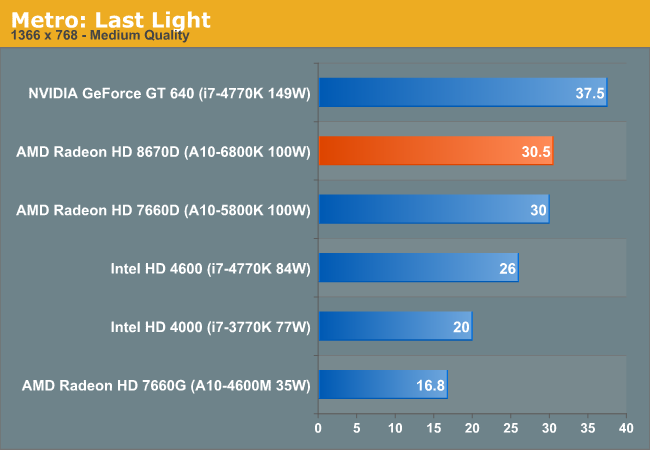
Looking at desktop parts alone, Intel really suffers from not having a socketed GT3 SKU. Although HD 4600 is appreciably faster than HD 4000 (+30%), both Trinity and Richland are around 17% faster than it. As you'll see, Metro ends up being one of the smaller gaps between the two in our suite.
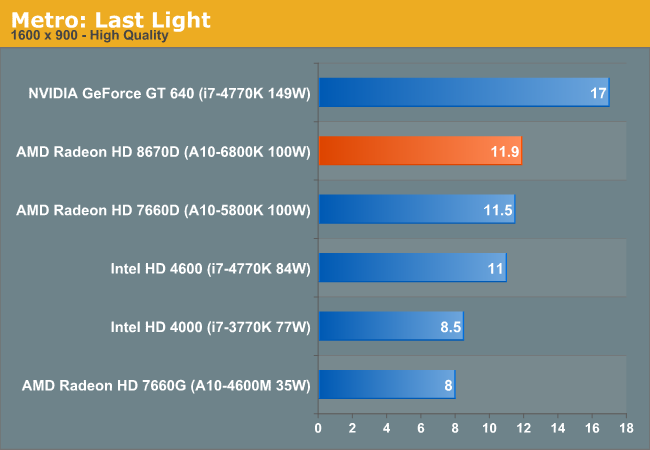
As memory bandwidth becomes the ultimate bounding condition, the gap between Richland and Haswell shrinks considerably. Note that on the HD 4600 side, the difference between DDR3-1333 and DDR3-2400 is only 10% here. Given the limited performance of the 20 EU Haswell GPU configuration, it doesn't seem like Intel is all that bandwidth limited here.
BioShock: Infinite
Bioshock Infinite is Irrational Games’ latest entry in the Bioshock franchise. Though it’s based on Unreal Engine 3 – making it our obligatory UE3 game – Irrational had added a number of effects that make the game rather GPU-intensive on its highest settings. As an added bonus it includes a built-in benchmark composed of several scenes, a rarity for UE3 engine games, so we can easily get a good representation of what Bioshock’s performance is like.
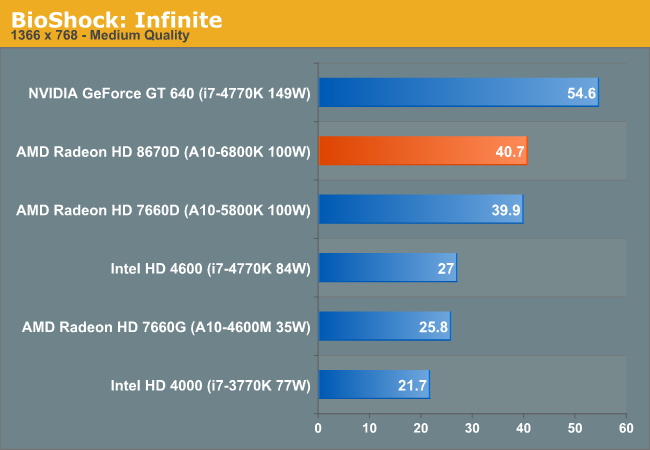
If Metro was an example of the worst case scenario for Richland, BioShock: Infinite is the best case scenario. Here the Radeon HD 8670D holds a 50% performance advantage over Intel's HD 4600 graphics.
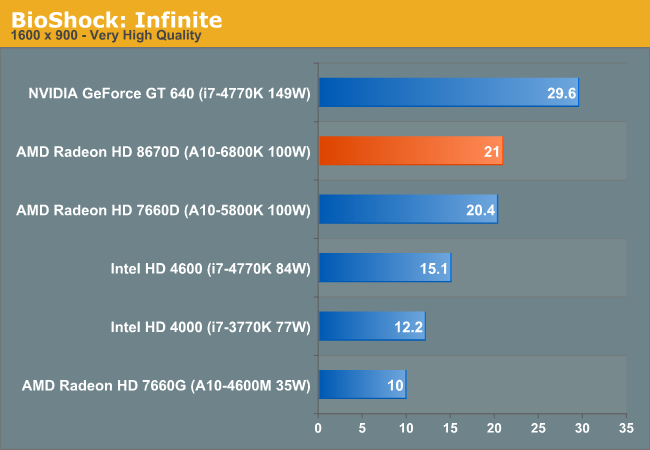
The gap narrows a bit at higher resolution/quality settings, but it's still 39%.
Sleeping Dogs
A Square Enix game, Sleeping Dogs is one of the few open world games to be released with any kind of benchmark, giving us a unique opportunity to benchmark an open world game. Like most console ports, Sleeping Dogs’ base assets are not extremely demanding, but it makes up for it with its interesting anti-aliasing implementation, a mix of FXAA and SSAA that at its highest settings does an impeccable job of removing jaggies. However by effectively rendering the game world multiple times over, it can also require a very powerful video card to drive these high AA modes.
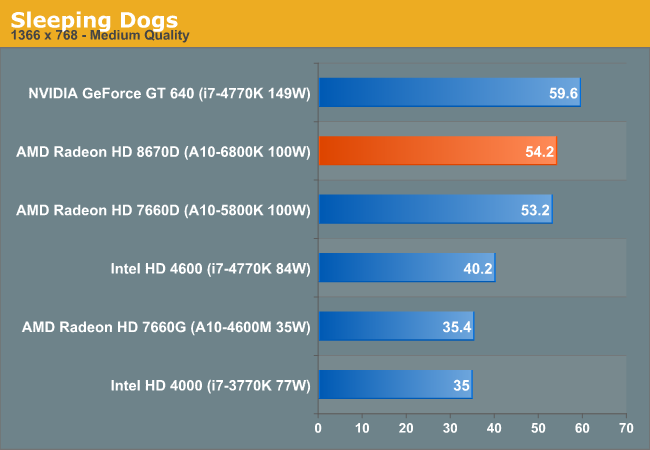
Richland is approaching 60 fps in our Sleeping Dogs benchmark at medium quality, definitely not bad at all. The advantage over Intel's HD 4600 is 34%.
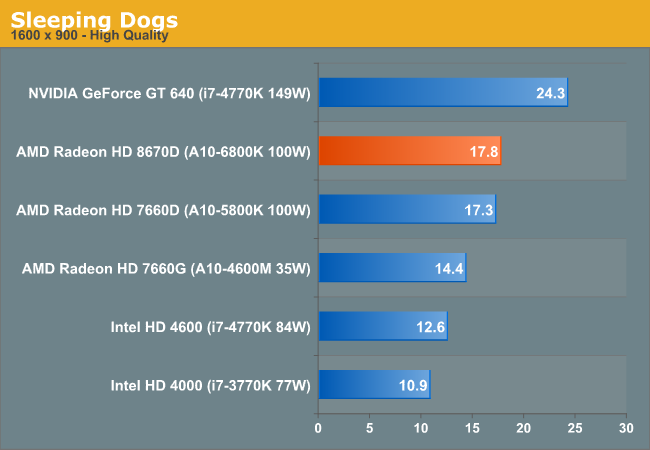
The performance advantage grows a bit at the higher quality/resolution settings, however we drop below the line of playability. With most of these games, you can trade off image quality for resolution however.
Tomb Raider (2013)
The simply titled Tomb Raider is the latest entry in the Tomb Raider franchise, making a clean break from past titles in plot, gameplay, and technology. Tomb Raider games have traditionally been technical marvels and the 2013 iteration is no different. iGPUs aren’t going to have quite enough power to use its marquee feature – DirectCompute accelerated hair physics (TressFX) – however even without it the game still looks quite good at its lower settings, while providing a challenge for our iGPUs.

Tomb Raider is another title that doesn't put Richland in the best light, but it still ends up around 23% faster than Haswell GT2.
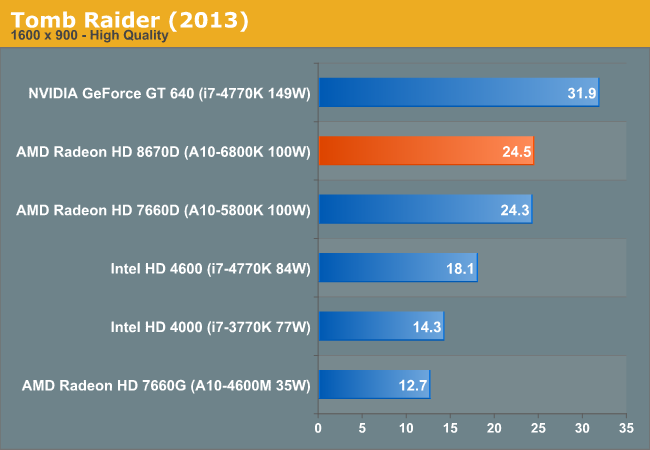
Battlefield 3
Our multiplayer action game benchmark of choice is Battlefield 3, DICE’s 2011 multiplayer military shooter. Its ability to pose a significant challenge to GPUs has been dulled some by time and drivers at the high-end, but it’s still a challenge for more entry-level GPUs such as the iGPUs found on Intel and AMD's latest parts. Our goal here is to crack 60fps in our benchmark, as our rule of thumb based on experience is that multiplayer framerates in intense firefights will bottom out at roughly half our benchmark average, so hitting medium-high framerates here is not necessarily high enough.
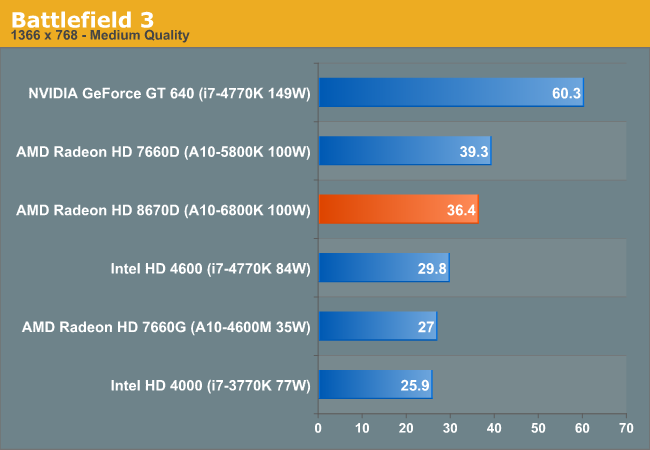
Richland's performance in Battlefield 3 climbs around 30% over the HD 4600 regardless of quality/resolution.

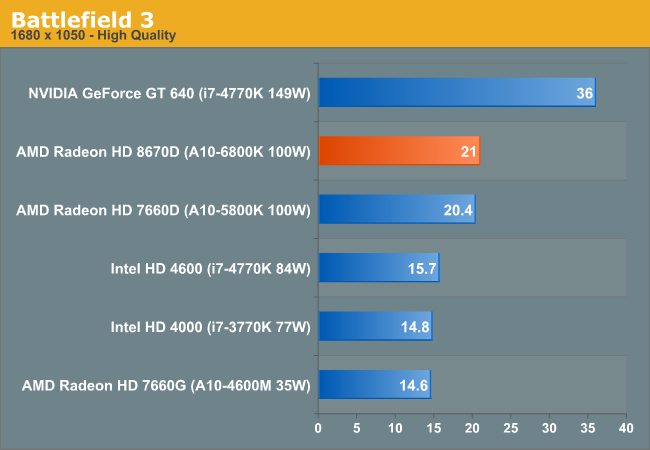
Crysis 3
With Crysis 3, Crytek has gone back to trying to kill computers, taking back the “most punishing game” title in our benchmark suite. Only in a handful of setups can we even run Crysis 3 at its highest (Very High) settings, and the situation isn't too much better for entry-level GPUs at its lowest quality setting. In any case Crysis 1 was an excellent template for the kind of performance required to drive games for the next few years, and Crysis 3 looks to be much the same for 2013.

Crysis is another benchmark where we see an increase in performance in the low 30% range.
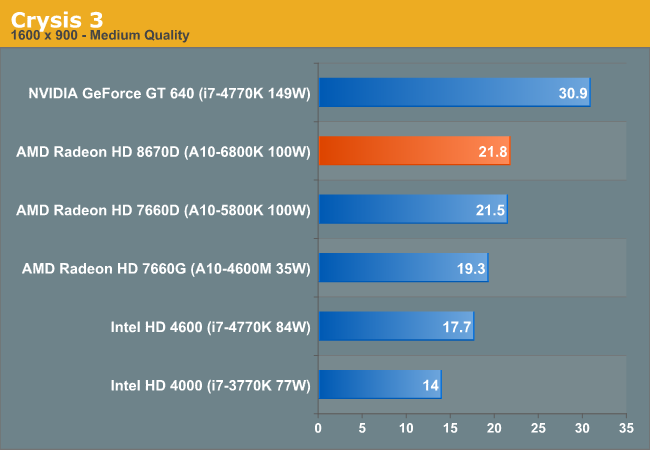











102 Comments
View All Comments
taltamir - Thursday, June 6, 2013 - link
"Richland maintains a 17 - 50% GPU performance advantage (~30% on average) over Intel's HD 4600 (Haswell GT2)"And yet consumes more then 2x the power according to your own charts.
And what about the CPU performance? These are desktop parts not laptop parts, their iGPU performance is meaningless
silverblue - Thursday, June 6, 2013 - link
Did you skip just to the conclusion? The reason as to a lack of CPU benchmarks is on the first page.How much power would a 4770K with a GT640 use, incidentally? And at the other end of the scale, what about that 4600M which is rated at 35W yet in a couple of tests beat even the 4770K with its HD 4600? You're asking for results that Anand hasn't managed to grab just yet for reasons as stated on the first page.
There's some strange results in here. In the 3DMark: Fire Strike Extreme test, all three APUs have the same result, but in 3DMark06, the 6800K significantly beats everything else. However, regardless of one or two oddities, the 6800K isn't a real progression over the 5800K... but it was never really made out nor expected to be.
FriendlyUser - Thursday, June 6, 2013 - link
Who cares about power on the desktop? What are you running, a server farm? We're not talking about a 200W part here. The Richland is easy enough to cool as it is. Just because intel based its strategy around a mobile part doesn't mean we have to run behind absolute power/performance ratios. Price/performance makes more sense for the average user.Also, iGPU is very important at that price point. If a $150 CPU saves you a $80 GPU, it's quite attractive. USA readers probably can afford to spend $200 for a dGPU, but struggling european economies and the developing world are a big part of the international market.
ChoadNamath - Thursday, June 6, 2013 - link
"iGPU performance is meaningless" ...except in an APU, where it's pretty much the whole point.shing3232 - Sunday, June 9, 2013 - link
it would not be meaningless for low end desktop. and it is not 2x power consumption in real world. they also have A10-6700 65W TDPwhyso - Thursday, June 6, 2013 - link
Well I think this also shows how close mobile will be. Gt2 at slightly lower speeds than the 4770k (say 1200 mhz 3MB cache for an i5/i3 vs 1300 mhz 8MB cache for 4770k) will be about 10-15% slower. Mobile trinity is going to be approximately equal to haswell mobile gt2 and richland may be slightly ahead but the gap is largely gone.FriendlyUser - Thursday, June 6, 2013 - link
I have always wondered why would anyone paying $330 for a high-end CPU care for a barely adequate iGPU. It's much more reasonable to expect that people looking at the $150 price point will appreciate an iGPU, especially one that is quite decent. The cheapest GT640 I could find was ~$85 (local price), which is no small change. And don't think that the GT640 will get the same scores if paired with the i3...whyso - Thursday, June 6, 2013 - link
yes it will, 640 is way to weak to be bottlenecked by an i3.Spunjji - Friday, June 7, 2013 - link
Indeed. It'll still cost more, though!BSMonitor - Thursday, June 6, 2013 - link
The vast majority of these CPUs do not go to gamers... Their performance is more than acceptable for a large number of use cases if an OEM doesn't want to include a dGPU. However for $330 you get CPU performance that AMD cannot touch at ANY price point or performance/watt..